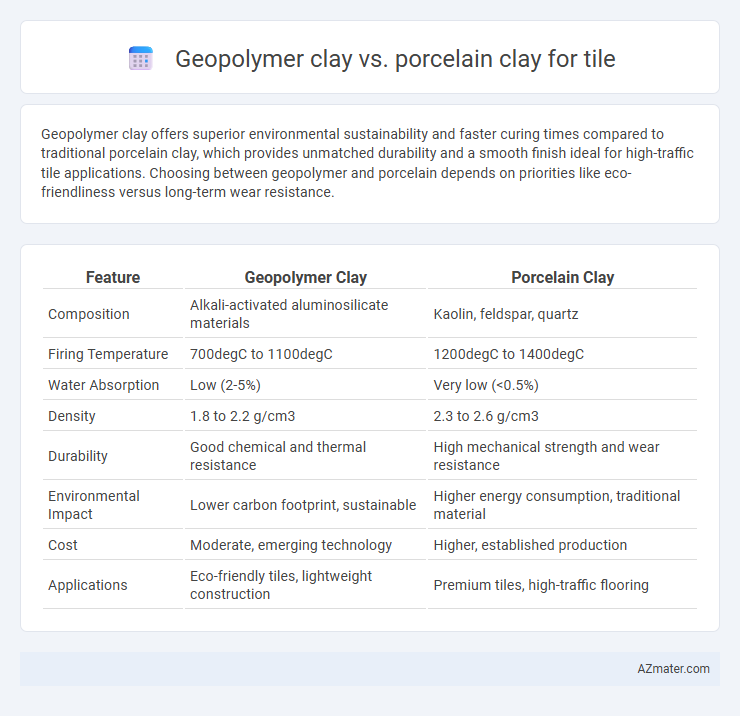Geopolymer clay offers superior environmental sustainability and faster curing times compared to traditional porcelain clay, which provides unmatched durability and a smooth finish ideal for high-traffic tile applications. Choosing between geopolymer and porcelain depends on priorities like eco-friendliness versus long-term wear resistance.
Table of Comparison
| Feature | Geopolymer Clay | Porcelain Clay |
|---|---|---|
| Composition | Alkali-activated aluminosilicate materials | Kaolin, feldspar, quartz |
| Firing Temperature | 700degC to 1100degC | 1200degC to 1400degC |
| Water Absorption | Low (2-5%) | Very low (<0.5%) |
| Density | 1.8 to 2.2 g/cm3 | 2.3 to 2.6 g/cm3 |
| Durability | Good chemical and thermal resistance | High mechanical strength and wear resistance |
| Environmental Impact | Lower carbon footprint, sustainable | Higher energy consumption, traditional material |
| Cost | Moderate, emerging technology | Higher, established production |
| Applications | Eco-friendly tiles, lightweight construction | Premium tiles, high-traffic flooring |
Understanding Geopolymer Clay: Composition and Properties
Geopolymer clay for tiles primarily consists of aluminosilicate materials activated by alkaline solutions, resulting in a low-carbon footprint alternative to traditional ceramics. Its composition enables enhanced durability, chemical resistance, and thermal stability compared to porcelain clay, which is typically made from kaolin, feldspar, and quartz. Understanding geopolymer clay's unique molecular network helps optimize tile performance for sustainable construction applications.
Porcelain Clay Explained: Key Features and Benefits
Porcelain clay offers exceptional durability, low porosity, and high resistance to moisture and staining, making it ideal for tile production. Its fine-grained texture ensures a smooth, dense surface that withstands heavy foot traffic and extreme temperatures. Compared to geopolymer clay, porcelain clay provides superior strength and a refined aesthetic, enhancing both functionality and visual appeal in tiled surfaces.
Manufacturing Processes: Geopolymer vs Porcelain Tiles
Geopolymer tiles are manufactured through a chemical reaction between aluminosilicate materials and alkaline activators, resulting in a rapid curing process at room temperature without the need for high-temperature kiln firing. In contrast, porcelain tiles undergo a traditional manufacturing process involving high-temperature firing above 1200degC, which vitrifies the clay, enhancing density and durability. The energy-efficient geopolymer process reduces carbon emissions compared to porcelain tile production, making it a sustainable alternative in ceramic manufacturing.
Mechanical Strength Comparison
Geopolymer clay exhibits higher compressive strength compared to porcelain clay, often exceeding 80 MPa, which enhances tile durability under heavy loads. Porcelain clay, while known for its hardness and low porosity, typically achieves compressive strengths around 50-70 MPa, making geopolymer tiles more resistant to mechanical stress and impact. The inherent chemical bonding in geopolymer tiles provides superior fracture toughness, reducing crack propagation relative to traditional porcelain counterparts.
Thermal and Chemical Resistance Analysis
Geopolymer clay exhibits superior thermal resistance compared to porcelain clay, withstanding temperatures above 1000degC without structural degradation due to its inorganic polymer matrix. Chemically, geopolymer clay resists acidic and alkaline environments more effectively than porcelain, attributed to its aluminosilicate framework that limits leaching and surface erosion. Porcelain clay, while offering moderate thermal stability up to about 1300degC, tends to be more susceptible to chemical attack in harsh environments, reducing its durability in industrial tile applications.
Environmental Impact and Sustainability
Geopolymer clay tiles exhibit significantly lower carbon emissions compared to porcelain clay due to their use of industrial byproducts like fly ash and slag, reducing reliance on virgin materials and minimizing waste. Porcelain clay requires high-temperature firing, consuming more energy and generating more greenhouse gases, while geopolymer clay cures at ambient temperatures, enhancing energy efficiency and decreasing environmental footprint. The durability and chemical resistance of geopolymer tiles also promote longer lifecycle use, supporting sustainability goals through reduced resource consumption and landfill waste.
Cost and Economic Considerations
Geopolymer clay offers a cost-effective alternative to porcelain clay in tile manufacturing due to its lower raw material expenses and reduced energy consumption during curing, resulting in significant savings on production costs. Porcelain clay, while typically more durable and valued for its aesthetic appeal, often incurs higher costs related to high-temperature firing and raw material sourcing. Evaluating the total lifecycle cost, including maintenance and longevity, geopolymer clay tiles can present superior economic value for budget-conscious construction projects.
Design Versatility and Aesthetic Options
Geopolymer clay offers exceptional design versatility due to its ability to incorporate various pigments and additives, enabling a wide range of textures and colors for tiles. Porcelain clay, known for its fine grain and smooth surface, provides a classic and highly durable aesthetic with limited color variation primarily in whites and earth tones. While geopolymer clay allows for more experimental and customizable tile designs, porcelain clay remains the preferred choice for sleek, elegant finishes with consistent quality.
Durability and Longevity in Real-World Applications
Geopolymer clay offers enhanced durability due to its superior chemical resistance and reduced porosity, making it ideal for high-traffic tile applications. Porcelain clay is known for its exceptional hardness and low water absorption rate, contributing to long-lasting tile surfaces in both indoor and outdoor environments. In real-world applications, geopolymer tiles resist cracking and chemical wear better, while porcelain tiles excel in maintaining structural integrity under heavy mechanical stress.
Ideal Use Cases: Choosing the Right Clay for Tiles
Geopolymer clay offers exceptional durability and chemical resistance, making it ideal for outdoor and industrial tile applications where weather and environmental exposure are concerns. Porcelain clay provides a dense, fine-grained texture with high mechanical strength and low porosity, perfect for indoor flooring and decorative tiles requiring a smooth, polished finish. Selecting the right clay depends on the tile's intended environment, with geopolymer clay suited for heavy-duty, long-lasting surfaces and porcelain clay favored for aesthetic appeal and refined interior use.

Infographic: Geopolymer clay vs Porcelain clay for Tile
 azmater.com
azmater.com